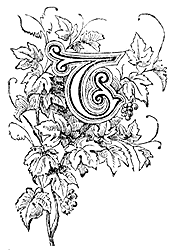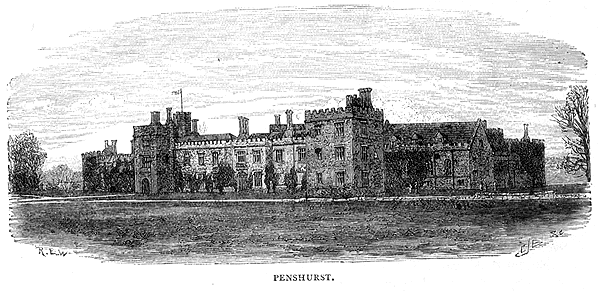 |
"Tread,
As with a pilgrim's reverential thoughts,
The groves of Penshurst." |

HE fine old home of the Sidneys has given great men
to serve our country, and is beautiful enough, from its surroundings, to
be a dwelling worthy of the race. Its grey walls and turrets, and its high
- peaked, red roofs, mingled with the more recent buildings of fresh stone,
give it a striking and venerable appearance. But the lovely valley above
which it rises, the woods and park stretching northwards, and the old church
and parsonage grouped in front, are its chief claims to the picturesque.
Valleys run out in every direction from the one in which it stands, and the
hills rise and wind charmingly at a little distance covered with woods and
fields and the graceful hop plantations. The park has ancient and renowned
trees in it; there are Sir Philip Sidney's Oak, Saccharissa's Walk, and Gamage's
Bower.
The house has two principal fronts - west and north. They are both
of great length The western front is of several dates and styles of architecture;
the facade is battlemented, and the centre division has large windows of
triple arches, with armorial shields between the upper and lower stories.
The south end is very ancient, with smaller mullioned windows; the northern
end has windows similar to the centre, but plainer and smaller. At each end
of this facade projects a wing with towers of various heights and sizes;
stone ones that are square, octagon ones of brick, etc. The northern front
facing up the park has been restored, and presents a battlemented range of
stone buildings of various projections; towers, turrets, and turreted chimneys.
The old gateway tower forms the principal entrance, and from the eastern
end of this front runs a fine avenue of limes.

The south side of Penshurst has all the irregularity of an old castle,
with its towers, projections, buttresses, and gables. The court that used
to be on this side is now a lawn.
The old banqueting hall is a grand specimen of the ancient baronial
hall of the fourteenth century, with its raised dais, its tall Gothic windows,
and the space marked out in the centre of the hall where of old the fire
burnt on the dogs, the smoke escaping through the centre of the high oak
roof.
On the right hand of the dais is the entrance into the cellar, from
whence many a stoup of wine or ale was wont to be brought to the great tables
in the hall. Passing this cellar entrance and ascending the loo stairs, the
ball room is reached - a large room with columns of verde-antique giallo
and porphyry from Italy.
It is said that Queen Elizabeth, when visiting Sir Henry Sidney,
furnished one of the apartments very splendidly. It is now called Queen Elizabeth's
room. The gilt chairs were covered with richly embroidered yellow and crimson
satin, and the walls of each end with the same, the embroidery having been
done by the queen and her ladies. But the chief interest of the apartment
is in the three portraits it contains of Sir Philip, Algernon, and Mary Sidney,
Countess of Pembroke.
Sir Philip Sidney - a perfect match for the French Bayard - is one
of the glories of England. The story of his gallant death, and of his generosity
at the battle of Zutphen in giving the water, for which his burning lips
craved, to a dying soldier, are known to all. But he was not only a gallant
and generous soldier, he was a poet and novelist; some of his sonnets are
very beautiful, in spite of the old language of his day being slightly different
from our present English. Here is one of them.
It was at Wilton, when with his accomplished sister, that Sidney
is said to have written the greater part of his "Arcadia," the first original
prose romance in our language. It is full of quaint beauties and brilliant
thoughts. He wrote also "Astrophel" and "Stella" and "Defence of Poetry."
The "Arcadia" embodies the very spirit of his age, and an heroic
tone of thought. Pamela's prayer in it was used by Charles I. before his
death, and has therefore a most touching interest for us. We will add the
closing portion of it as a specimen of the noble nature of the poet and of
the king who sympathised with him. "Let the power of my enemies prevail,
but prevail not to my destruction. Let my greatness he their prey; let my
pain be the sweetness of their revenge; let them, if so it seem good unto
Thee, vex me with more and more punishment; but, O Lord, let never their
wickedness have such a hand, but that I may carry a pure mind in a pure body."
This warrior and poet was also the very model of a courtier, but
without the baseness of the mere flatterer. Elizabeth called him the brightest
jewel of her Crown, and Lord Brooke thought it the greatest glory of his
life that he could have inscribed on his tomb, THE FRIEND OF SIR PHILIP SIDNEY.
His domestic virtues were equally remarkable; he was the best of
sons to a most noble father - Sir Henry Sidney (in whose arms King Edward
VI. died), and he was the most affectionate and generous of brothers to young
Robert Sidney and his beloved sister Mary. The latter, the Countess of Pembroke,
equalled him in fine qualities and intellectual gifts. He was the idol of
his times, both in his native home and on the Continent, and for his chivalrous
character and virtue the Crown of Poland was actually offered to him.
Sir Philip's portrait must have been taken when he was about two
or three and twenty. His dress is a rich laced doublet of pale crimson, a
ruff his neck, and a scarlet mantle hanging loosely from his shoulder. He
has clear earnest eyes and ruddy brown hair. He is standing reading with
a staff of office in his hand.
Algernon Sidney's portrait is similar to the engravings of him.
He is standing by a column, leaning on a folio book labelled LIBERTAS; his
buff coat, scarlet sash, and steel cuirass are the dress of the age. His
is a stern and melancholy countenance, and as in the background are the Tower
and the axe, it must have been painted after his execution.
The women of the house of Sidney have also been distinguished. Dorothy
Sidney, "Saccharissa," was immortalised by Waller, and at Penshurst a noble
avenue of beeches is still called Saccherissa's Walk.
Sir Philip Sidney was buried in St. Paul's Cathedral. "His wit and
understanding," says his friend Lord Brooke, "beat upon his heart to make
himself and others, not in word or opinion, but in life and action, good
and great."
|
 |